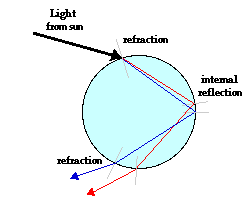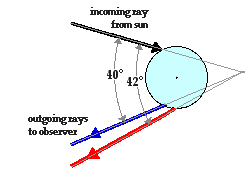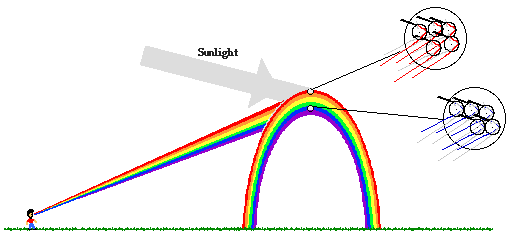Hold down the T key for 3 seconds to activate the audio accessibility mode, at which point you can click the K key to pause and resume audio. Useful for the Check Your Understanding and See Answers.
One of nature's most splendid masterpieces is the rainbow. A rainbow is an excellent demonstration of the dispersion of light and one more piece of evidence that visible light is composed of a spectrum of wavelengths, each associated with a distinct color. To view a rainbow, your back must be to the sun as you look at an approximately 40 degree angle above the ground into a region of the atmosphere with suspended droplets of water or even a light mist. Each individual droplet of water acts as a tiny prism that both disperses the light and reflects it back to your eye. As you sight into the sky, wavelengths of light associated with a specific color arrive at your eye from the collection of droplets. The net effect of the vast array of droplets is that a circular arc of ROYGBIV is seen across the sky. But just exactly how do the droplets of water disperse and reflect the light? And why does the pattern always appear as ROYGBIV from top to bottom? These are the questions that we will seek to understand on this page of The Physics Classroom Tutorial. To understand these questions, we will need to draw upon our understanding of refraction, internal reflection and dispersion.
The Path of Light Through a Droplet
A collection of suspended water droplets in the atmosphere serves as a refractor of light. The water represents a medium with a different optical density than the surrounding air. Light waves refract when they cross over the boundary from one medium to another. The decrease in speed upon entry of light into a water droplet causes a bending of the path of light towards the normal. And upon exiting the droplet, light speeds up and bends away from the normal. The droplet causes a deviation in the path of light as it enters and exits the drop.
 There are countless paths by which light rays from the sun can pass through a drop. Each path is characterized by this bending towards and away from the normal. One path of great significance in the discussion of rainbows is the path in which light refracts into the droplet, internally reflects, and then refracts out of the droplet. The diagram at the right depicts such a path. A light ray from the sun enters the droplet with a slight downward trajectory. Upon refracting twice and reflecting once, the light ray is dispersed and bent downward towards an observer on earth's surface. Other entry locations into the droplet may result in similar paths or even in light continuing through the droplet and out the opposite side without significant internal reflection. But for the entry location shown in the diagram at the right, there is an optimal concentration of light exiting the airborne droplet at an angle towards the ground. As in the case of the refraction of light through prisms with nonparallel sides, the refraction of light at two boundaries of the droplet results in the dispersion of light into a spectrum of colors. The shorter wavelength blue and violet light refract a slightly greater amount than the longer wavelength red light. Since the boundaries are not parallel to each other, the double refraction results in a distinct separation of the sunlight into its component colors.
There are countless paths by which light rays from the sun can pass through a drop. Each path is characterized by this bending towards and away from the normal. One path of great significance in the discussion of rainbows is the path in which light refracts into the droplet, internally reflects, and then refracts out of the droplet. The diagram at the right depicts such a path. A light ray from the sun enters the droplet with a slight downward trajectory. Upon refracting twice and reflecting once, the light ray is dispersed and bent downward towards an observer on earth's surface. Other entry locations into the droplet may result in similar paths or even in light continuing through the droplet and out the opposite side without significant internal reflection. But for the entry location shown in the diagram at the right, there is an optimal concentration of light exiting the airborne droplet at an angle towards the ground. As in the case of the refraction of light through prisms with nonparallel sides, the refraction of light at two boundaries of the droplet results in the dispersion of light into a spectrum of colors. The shorter wavelength blue and violet light refract a slightly greater amount than the longer wavelength red light. Since the boundaries are not parallel to each other, the double refraction results in a distinct separation of the sunlight into its component colors.
 The angle of deviation between the incoming light rays from the sun and the refracted rays directed to the observer's eyes is approximately 42 degrees for the red light. Because of the tendency of shorter wavelength blue light to refract more than red light, its angle of deviation from the original sun rays is approximately 40 degrees. As shown in the diagram, the red light refracts out of the droplet at a steeper angle toward an observer on the ground. There are a multitude of paths by which the original ray can pass through a droplet and subsequently angle towards the ground. Some of the paths are dependent upon which part of the droplet the incident rays contact. Other paths are dependent upon the location of the sun in the sky and the subsequent trajectory of the incoming rays towards the droplet. Yet the greatest concentration of outgoing rays is found at these 40-42 degree angles of deviation. At these angles, the dispersed light is bright enough to result in a rainbow display in the sky. Now that we understand the path of light through an individual droplet, we can approach the topic of how the rainbow forms.
The angle of deviation between the incoming light rays from the sun and the refracted rays directed to the observer's eyes is approximately 42 degrees for the red light. Because of the tendency of shorter wavelength blue light to refract more than red light, its angle of deviation from the original sun rays is approximately 40 degrees. As shown in the diagram, the red light refracts out of the droplet at a steeper angle toward an observer on the ground. There are a multitude of paths by which the original ray can pass through a droplet and subsequently angle towards the ground. Some of the paths are dependent upon which part of the droplet the incident rays contact. Other paths are dependent upon the location of the sun in the sky and the subsequent trajectory of the incoming rays towards the droplet. Yet the greatest concentration of outgoing rays is found at these 40-42 degree angles of deviation. At these angles, the dispersed light is bright enough to result in a rainbow display in the sky. Now that we understand the path of light through an individual droplet, we can approach the topic of how the rainbow forms.
The Formation of the Rainbow
A rainbow is most often viewed as a circular arc in the sky. An observer on the ground observes a half-circle of color with red being the color perceived on the outside or top of the bow. Those who are fortunate enough to have seen a rainbow from an airplane in the sky may know that a rainbow can actually be a complete circle. Observers on the ground only view the top half of the circle since the bottom half of the circular arc is prevented by the presence of the ground (and the rather obvious fact that suspended water droplets aren't present below ground). Yet observers in an airborne plane can often look both upward and downward to view the complete circular bow.
The circle (or half-circle) results because there are a collection of suspended droplets in the atmosphere that are capable concentrating the dispersed light at angles of deviation of 40-42 degrees relative to the original path of light from the sun. These droplets actually form a circular arc, with each droplet within the arc dispersing light and reflecting it back towards the observer. Every droplet within the arc is refracting and dispersing the entire visible light spectrum (ROYGBIV). As described above, the red light is refracted out of a droplet at steeper angles towards the ground than the blue light. Thus, when an observer sights at a steeper angle with respect to the ground, droplets of water within this line of sight are refracting the red light to the observer's eye. The blue light from these same droplets is directed at a less steep angle and is directed along a trajectory that passes over the observer's head. Thus, it is the red light that is seen when looking at the steeper angles relative to the ground. Similarly, when sighting at less steep angles, droplets of water within this line of sight are directing blue light to the observer's eye while the red light is directed downwards at a more steep angle towards the observer's feet. This discussion explains why it is the red light that is observed at the top and on the outer perimeter of a rainbow and the blue light that is observed on the bottom and the inner perimeter of the rainbow.

Rainbows are not limited to the dispersion of light by raindrops. The splashing of water at the base of a waterfall caused a mist of water in the air that often results in the formation of rainbows. A backyard water sprinkler is another common source of a rainbow. Bright sunlight, suspended droplets of water and the proper angle of sighting are the three necessary components for viewing one of nature's most splendid masterpieces.